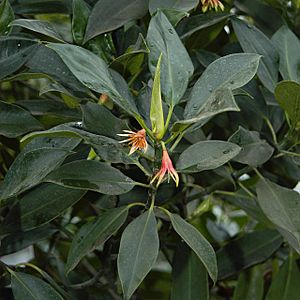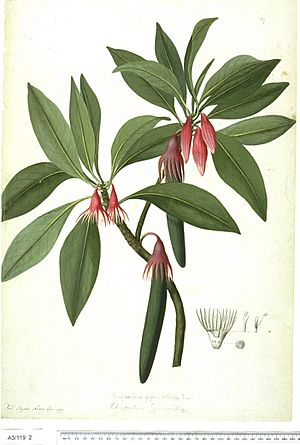Large-leafed orange mangrove facts for kids
Quick facts for kids Large-leafed orange mangrove |
|
|---|---|
 |
|
| Scientific classification | |
| Genus: |
Bruguiera
|
| Species: |
gymnorhiza
|
| Synonyms | |
Bruguiera gymnorhiza is a special kind of mangrove tree. It usually grows to be about 7 to 20 meters tall, but some can reach up to 35 meters! This tree is part of the Rhizophoraceae family. You can often find it growing near the ocean in mangrove swamps, sometimes next to other Rhizophora trees. It lives in many places, from the western Pacific Ocean all the way across the Indian Ocean to South Africa.
Contents
What it Looks Like
This tree can grow very tall, sometimes as high as a 10-story building, but it's usually a bit shorter. It has a smooth trunk with reddish-brown bark. Unlike some other mangroves, it has short prop-roots instead of long stilt-roots that stick out of the water.
Its leaves are green and shaped like an oval, about 5 to 15 centimeters long. The flowers are white or cream-colored when they first open, but they quickly turn brown. They are about 1.5 centimeters long. The fruit looks like a spinning top and is about 2 centimeters long. When the fruit is ready, it drops into the mud and stands upright. It then quickly grows roots. The seeds, while still on the tree, have a long part called a hypocotyl, which can be up to 11 centimeters long.
Where it Lives
This tree is found naturally along the coasts of many countries. It lives around the Indian Ocean, the South China Sea, and parts of the western Pacific Ocean.
Some of the places where it grows include:
- Islands like Samoa, Fiji, Marshall Islands, and Maldives.
- Countries in Asia such as India, Sri Lanka, Thailand, Vietnam, and Indonesia.
- Parts of Australia like Queensland and the Northern Territory.
- Countries in Africa like Madagascar, Kenya, Tanzania, and South Africa.
It used to grow in Taiwan but is now gone from there. It has also started growing in Florida, USA.
Its Home and Habitat
Bruguiera gymnorhiza loves to grow in muddy areas where the ocean tides come and go. These are called intertidal mud-flats and estuaries. It prefers parts of the coast that are not too exposed to strong waves. It can grow in different types of soil, but it grows best in river estuaries.
The tree needs salty water and muddy soil to spread its roots. It often grows with other mangrove species in these areas. In South Africa, this tree is protected, meaning it's against the law to harm it.
Different Names
Besides its scientific name, Bruguiera gymnorhiza has many common names around the world. Here are just a few examples:
- In the Marshall Islands, it's called jon.
- In northern Australia, it's known as the orange mangrove.
- In Papua New Guinea, people call it kavela or mangrove bean.
- In Palau, it's denges.
- In Indonesia, it's putut.
- In Malaysia, it's pokok tumu merah.
- In Cambodia, it has names like prâsak' nhi.
- In Thailand, it's phangka hua sum dok daeng.
- In India, it's called thuddu ponna or uredi.
- In the Maldives, it's bodu kaṇḍū.
- In Kenya and Tanzania, it's known as muia or mkoko wimbi.
- In South Africa, it's called swart-wortelboom in Afrikaans or black mangrove in English.
- In English, it's also known as large-leafed mangrove or oriental mangrove.
How People Use It
This mangrove tree is very useful! People use it for many things, especially its wood.
Wood Products
The wood from Bruguiera gymnorhiza is used for:
- Firewood: It burns well and is used as fuel in many places, like some Pacific Islands. It's also used to make charcoal.
- Building: The strong wood is used to build houses, including poles, beams, and rafters.
- Boats: Parts of canoes, like the keel and outrigger, are made from this wood.
- Tools: People make fishing stakes, spears, tool handles, and digging sticks from it.
- Other uses: In the Andaman Islands, its trunks have even been used for telephone poles because the wood doesn't rot easily.
Food Source
The fruit of this tree, especially the long hypocotyl (the part that grows from the seed while it's still on the tree), is eaten in many places.
- In Melanesia and Nauru, people scrape, wash, dry, and cook the fruit to remove bitter substances called tannins. Sometimes they mix it with coconut.
- In the Solomon Islands, the fruit is sold as a vegetable in markets.
- For the Sowek people in Indonesia, the fruit is a main part of their diet because it has a lot of carbohydrates.
- Many Indigenous groups in northern Australia also eat the green hypocotyls. They might bake them, mash them, and then soak them in water.
- In Papua New Guinea, the cooked hypocotyls are a staple food.
- People in India, Bangladesh, and other parts of Southeast Asia also eat the hypocotyls.
- In the Maldives, the green pods are peeled and boiled multiple times, with the water changed, before being eaten as a cooked vegetable.
Medicinal Uses
The bark of the tree has some medicinal properties:
- In the Solomon Islands, the bark is used to treat burns.
- In Indonesia, it's used for diarrhea and fever.
- In Cambodia, the bark has been used to help with malaria.
- The fruit itself has properties that can fight viruses.
- Bark from a similar tree, Bruguiera sexangula, has even shown signs of fighting some types of cancerous tumors.
Other Uses
- Dye: The bark is used to make dyes, creating colors from red-brown to black. It needs to be dyed many times to get a dark color.
- Tanning: The bark has a lot of tannins, which are used to treat animal skins to make leather.
Images for kids
See also
 In Spanish: Bacao de Filipinas para niños
In Spanish: Bacao de Filipinas para niños




